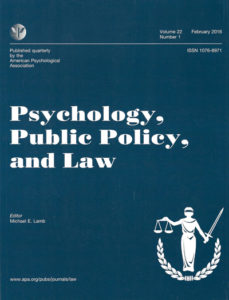 Dr. Cunningham and colleagues, Dr. Tom Reidy and Dr. Jon Sorensen, have published important findings in Psychology, Public Policy, and Law. The confinement of capital punishment (death-sentenced) inmates nationwide is typified by marked interpersonal isolation and activity deprivation on segregated death rows. These super maximum security measures are ostensibly based on an assumption that capital punishment inmates are at high risk for violence. Super maximum confinement on death row has high costs: fiscal, staffing, and psychological. This study provided a 25-year follow-up on the Missouri Department of Corrections unique policy of “mainstreaming” capital punishment inmates into the general population of the Potosi Correctional Center (PCC). Findings remained consistent in showing that mainstreamed capital punishment inmates (N = 85) had equivalent or lower rates of violent misconduct than inmates serving life-without-parole (N = 702) or term-sentences (N = 3,000). The failure of assumptions of high violence risk undergirding death row has important public policy and correctional implications.
Dr. Cunningham and colleagues, Dr. Tom Reidy and Dr. Jon Sorensen, have published important findings in Psychology, Public Policy, and Law. The confinement of capital punishment (death-sentenced) inmates nationwide is typified by marked interpersonal isolation and activity deprivation on segregated death rows. These super maximum security measures are ostensibly based on an assumption that capital punishment inmates are at high risk for violence. Super maximum confinement on death row has high costs: fiscal, staffing, and psychological. This study provided a 25-year follow-up on the Missouri Department of Corrections unique policy of “mainstreaming” capital punishment inmates into the general population of the Potosi Correctional Center (PCC). Findings remained consistent in showing that mainstreamed capital punishment inmates (N = 85) had equivalent or lower rates of violent misconduct than inmates serving life-without-parole (N = 702) or term-sentences (N = 3,000). The failure of assumptions of high violence risk undergirding death row has important public policy and correctional implications.






